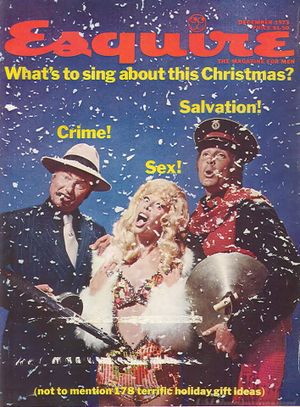Esquire (magazine)
Esquire is a magazine for men owned by the Hearst Corporation. Founded in 1933, it flourished during the Depression under the guidance of founder and editor Arnold Gingrich.
Although the magazine began as a racy publication for men, it soon transformed itself into a more refined periodical with an emphasis on men's fashion and contributions by such literary giants as Ernest Hemingway and F. Scott Fitzgerald. In the 1940s, the popularity of the famous Vargas Girls provided a circulation boost. In the 1960s, Esquire helped pioneer the trend of New Journalism by publishing such writers as Norman Mailer, Tim O'Brien, John Sack, Gay Talese and Tom Wolfe.
Esquire magazine under Harold Hayes, who ran it from 1961 to 1973, was as distinctive as its oversized pages. The magazine shrank to the conventional 8 1/2 X 11 in 1971.
Fiction
From 1969 to 1976, Gordon Lish served as fiction editor for Esquire magazine and became known as "Captain Fiction" because of the authors whose careers he assisted. Lish helped establish the career of writer Raymond Carver by publishing his short stories in Esquire, often over the objections of Hayes. Lish is noted for encouraging Carver's minimalism and publishing the short stories of Richard Ford. Using the influential publication as a vehicle to introduce new fiction by emerging authors, he promoted the work of such writers as T. Coraghessan Boyle, Barry Hannah, Cynthia Ozick and Reynolds Price. Other authors appearing in Esquire at that time included William F. Buckley, Truman Capote, Murray Kempton, Malcolm Muggeridge, Ron Rosenbaum, Andrew Vachss and Garry Wills. The magazine's policy of nurturing young writing talent continued with Elizabeth Gilbert and others.
In February 1977, Esquire published "For Rupert - with no promises" as an unsigned work of fiction. This was the first time in Esquire's 44-year history that it did not identify a fiction writer. Readers speculated that it was the work of J. D. Salinger, the reclusive author best known for The Catcher in the Rye. The story is told in first-person and features events and Glass family names from the story "For Esmé with Love and Squalor".
Gordon Lish is quoted as saying,
- "I tried to borrow Salinger's voice and the psychological circumstances of his life, as I imagine them to be now. And I tried to use those things to elaborate on certain circumstances and events in his fiction to deepen them and add complexity."
- The Wall Street Journal (February 25, 1977)
Design
Art directors have included Jean-Paul Goude, Paul Rand, Roger Black and Samuel Antupit also during the the 1930's the magazine was the starting point for many illustrators like Santiago Martinez Delgado. Using the techniques of print advertising, legendary adman George Lois, the youngest inductee into the Art Directors Hall of Fame, designed clever, eye-catching Esquire covers during the 1960s, such as Sonny Liston as Santa Claus and Andy Warhol drowning in a can of soup to illustrate an article on the death of the avant-garde. Lois' covers raised Esquire's circulation in ten years from 500,000 to two million.
For many years, Esquire published its annual Dubious Achievement Awards, lampooning events of the preceding year. As a running gag, the annual article almost always displayed an old photo of Richard Nixon laughing, with the caption, "Why is this man laughing?" However, the February 2006 "Dubious Achievement Awards" used the caption under a photo of W. Mark Felt, the former FBI official revealed in 2005 to be the "Deep Throat" Watergate source for Bob Woodward and Carl Bernstein. Esquire did not publish "Dubious Achievement Awards" for 2001 or 2002, but resumed them with the 2003 awards, published in the February 2004 issue.
Chat rooms • What links here • Copyright info • Contact information • Category:Root
